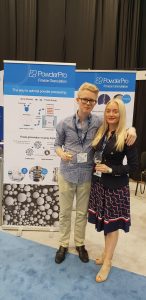Ilaria Zanoni, Valentina Fiorini, Marcos Rosado, Belén Ballesteros, Maria Androulidaki, Magda Blosi, Simona Ortelli, Stefano Stagni, Michele Dondia and Anna Luisa Costa
Abstract
Herein we report the easy incorporation of brightly phosphorescent cationic iridium(III) tetrazole complexes into a silica based matrix via an easily scalable colloidal process. For this purpose, two cationic Ir(III) emitters bearing 5-aryl tetrazole ligands (R-CN4) were selected: blue [F2IrPTZ-Me]+ (C^N = F2ppy; N^N = PTZ-Me – 2-(2-methyl-2H-tetrazol-5-yl)pyridine) and red [IrQTZ-Me]+ (C^N = ppy; N^N = QTZ-Me – 2-(2-methyl-2H-tetrazol-5-yl)quinoline). The cationic complexes were readily adsorbed to negatively charged silica nanoparticles and trapped in the sol–gel matrix. The sol-to-solid phase transfer was performed by using an innovative spray-freeze-drying technique, leading to the formation of phosphorescent solid micro-granules. The structural and optical characterisation of the Ir(III) complexes together with SiO2 nanoparticles, nanosols (Ir@SiO2) and powders (Ir@SiO2 powders), revealed how the presence of the Ir(III)-based complexes did not alter the morphology of the colloidal silica or granulated phases. Moreover, the silica matrix did not interfere with the optical properties of the embedded complexes. The distribution of [F2IrPTZ-Me]+ and [IrQTZ-Me]+ in the spray-freeze-dried powders was qualitatively evaluated by fluorescence microscopy, revealing how the luminescent particles were homogeneously dispersed all over the silica matrix. Interestingly, in aqueous solution the release of complex [F2IrPTZ-Me]+ from the corresponding Ir@SiO2 powder is almost negligible, therefore suggesting that a strong interaction occurs between the host–silica matrix and the Ir(III) guest complex.











